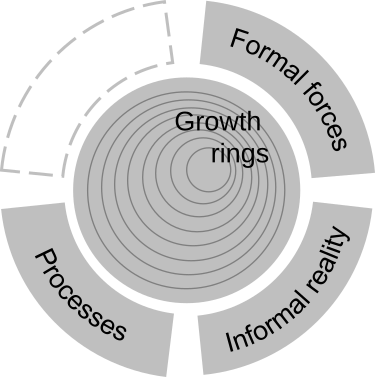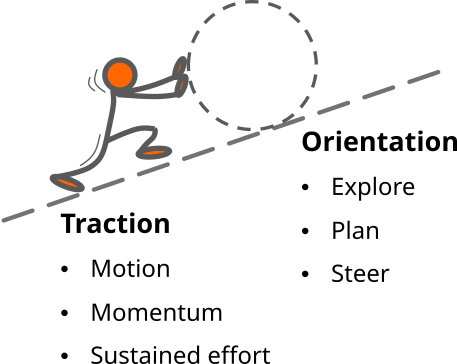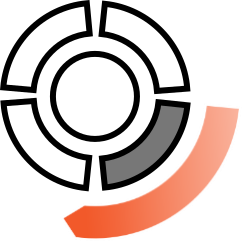E.N.E.R.G.Y. for Change Flywheel
Abstract
Successful change implementation hinges on people, and while not everything is malleable, effective guidance and support can significantly improve outcomes. Propel your change initiative towards success by adopting the E.N.E.R.G.Y. for Change Flywheel. This model, centred on the people side of change, addresses most common root causes of failing change. It provides an approach and tools to craft a promising change plan, gain traction, and navigate the intricate dynamics of change.
The flywheel, illustrated to the right, identifies 4, potentially 5 brakes on change, 2 navigational areas, and 4 traction areas, all containing a multitude of tools. Developed, practiced, and refined over 30 years, this flexible modular framework stands alone or integrates seamlessly with project management methods, allowing users to customize tool usage.
This document offers a high-level description of the forces influencing people's adoption of change and outlines key considerations for successful change realization. For further inquiries or comments, please contact me at wally@propulse.partners.

Introduction
Initiators and senders of change often hold positive views of ’their’ change. Receivers of change however, tend to be less enthusiastic. The reality is that three-quarters of change initiatives fall short. Researched causes point to the human factor. Enter the E.N.E.R.G.Y. for Change Flywheel—a model and modular tool-rich framework addressing the human factors that make and break change success. Developed, used and improved over three decades, this framework has demonstrated to be very effective over a range of industries, in various cultural settings and wildly differing situations.
It stands as a valuable resource for leaders, consultants, mentors, and change trainers. The journey of driving successful change is ongoing, and this framework invites collaboration to further enhance its effectiveness. As we strive for continuous improvement, let’s drive change together.
Drivers and Brakes on Change: Understanding the Forces
Humans and organizations seek predictability and habit. This fosters efficiency, quality and stability and lie at the base for growth. To this end we install and cherish various stabilizing forces in our organisations. However, various stabilizing forces that optimize in a 'steady state' will become brakes on change. These forces fall into four categories. Depending on how you drive the change, potentially five. Let’s have a look at them.


Formal Forces
These include formal documents, regulations, policies, strategies, objectives, decisions, formal culture and other elements that help to structure and give direction to the organisation. Separately, they may either accelerate or impede change. One real life example is a BU director who refuses to drive a change. Investing time in the change will jeopardize the attainment of his bonus.

Informal Realities
Maybe you have experienced informal realities where subgroups covertly question authority or divert from formal plans, regulation. Often instigated by different beliefs, ’private’ agendas, or informal power. Informal realities can have positive effects but also hinder unity and execution power. They can be very strong and tenacious. In a positive manner, think of friendly jokes about the manager’s behaviour to take off the sharp edges or in a negative version, to covertly ridicule ideas.

Processes and Skills
To the third group we reckon processes, systems and routines, that people adhere to as well as the skills needed to produce the product or service that the unit has as output. Think how accustomed we get to what and how we do things. Change may require to depart from ingrained ways of working, causing resistance.

Growth rings
Our individual biases, opinions, and attitudes formed over years of experience, shape our responses to aspects that do or do not fit our established logic or beliefs. Think of the situation where someone, at a former employer, some time ago has been part of a very problematic ERP implementation. His/her current employer will now implement the same ERP system. This person now has problems to believe what the system integrator is saying and support this change.

The potential fifth enabler or brake, I will come to talk about later in this document.
Hoping for an ideal and smooth 'wind at your the back' scenario in change, will most likely prove to be naive. It is only realistic to anticipate one or more types of brakes will be at work during your change implementation and that there will be some swim against the against the current. This requires thorough preparation and sound execution.

Therefore, work with the six elements of the E.N.E.R.G.Y. for Chang Flywheel.
- Explore & Navigate for orientational purposes and,
- Encourage, Release, Grow and Youthen as traction elements
They help to turn brakes in change into positive drivers to create motion and sustained positive momentum.
2 Elements for orientation: Explore & Navigate

Explore
While much focus is typically directed towards the 'technical' and instrumental facets of change, there is often insufficient consideration for how the recipients perceive these changes, and additionally, during the change process, how the situation develops. Incomplete comprehension of the fundamental aspects of the change at hand, and a lack of awareness regarding the (developing) context are frequent contributors to the shortcomings observed in change initiatives. In Explore, we not only evaluate the context but also delve into the width and depth of the change from both the sender's and receiver's perspectives. This comprehensive approach includes a toolset and provides crucial insights, essential for developing a promising change plan. Regular monitoring the developing situation helps to identify if the plan or execution needs adaptation.

Navigate
This involves crafting a robust change plan that aligns with budgetary constraints and timelines, minimizing disruptions to daily operations. A plan that goes beyond prioritizing ’technical’ aspects and takes into account how receivers of change learn and adapt. Navigating the change also involves securing flexibility to adapt in response to unforeseen challenges.
4 Elements for traction and sustained momentum: Encourage, Release, Grow & Youthen

Encourage
This involves reinforcing and aligning formal forces to generate a positive change push. While it is often specific to the case at hand, common practices include enhancing change competence, ensuring effective communication that not only explains the 'why' and 'what' but also causes receivers of change to actively support the change. Other key considerations include creating unity within the change leadership team, reviewing of change-hindering routines, and addressing time constraints.

Release
In ’Release’ we focus on mobilizing and amplifying already existing motivation and competence to act as effective and sustained pull for the change. Where needed this also comprises influencing the informal network as real progress and adoption is severely hampered as long as informal leaders across relevant parts of the organisation do not support the change.

Grow
Less than desired competence is what we tend to see towards the end of a project. This is regrettable, given the considerable time and financial investments organisations make, along with the effort needed to build expertise. Our approach to upskilling involves methods to attain higher competence levels with minimal disruption to daily operations. We've identified enhancements that demand less time and yield greater value more rapidly, termed as 'Receiver Orientation' and 'High- Frequency Micro Learning'.

Youthen
Youthen, meaning to make youthful in behaviour, or qualities of mind or feeling. While our accumulated experience, represented by 'growth rings,' provides immense value, there are instances where old ideas and logic lose their relevance and require rejuvenation, need to be youthened. In order to whole heartedly adapt or find new ways. Youthen involves providing individual or small group support for colleagues encountering challenges in adapting to the new or finding new pathways. It is about compassion for your people and aligns with self-interest as a leader as this mitigates sympathetic negativism, fostering a more positive environment and encouraging others to enthusiastically embrace and master the new.
Oh yes, and how about the fifth brake or enabler? Depending how senders of change on all levels, plan, execute and steer the change process, will greatly define the level to which their efforts are met with resistance or positive energy. Correct usage of this Flywheel and belonging tools will help to get positive resonance. Also, in the more impactful changes.
Closing words and recap
The E.N.E.R.G.Y. for Change Flywheel is grounded in the belief that only positive and enduring energy, from both initiators, senders and receivers propels long lasting change success. The flywheel metaphor encapsulates the essence of providing stability and accessible power, ensuring an unbroken drive for change.
As all six elements harmonize, they generate movement and sustained momentum, propelling change forward.

Get acquainted with the E.N.E.R.G.Y. for Change Flywheel. This unique framework supports receivers of change to become motivated and competent for the change. Usage of this framework will render more benefit faster, easier. It seamlessly integrates with project management methodologies and other change models, providing organisations the flexibility to incorporate tools of their preference.
Looking forward to hear your reactions and ideas to make it even better.
Wally van Heukelom
Founder of Propulse People
Performance Owner of ProPePe AB.